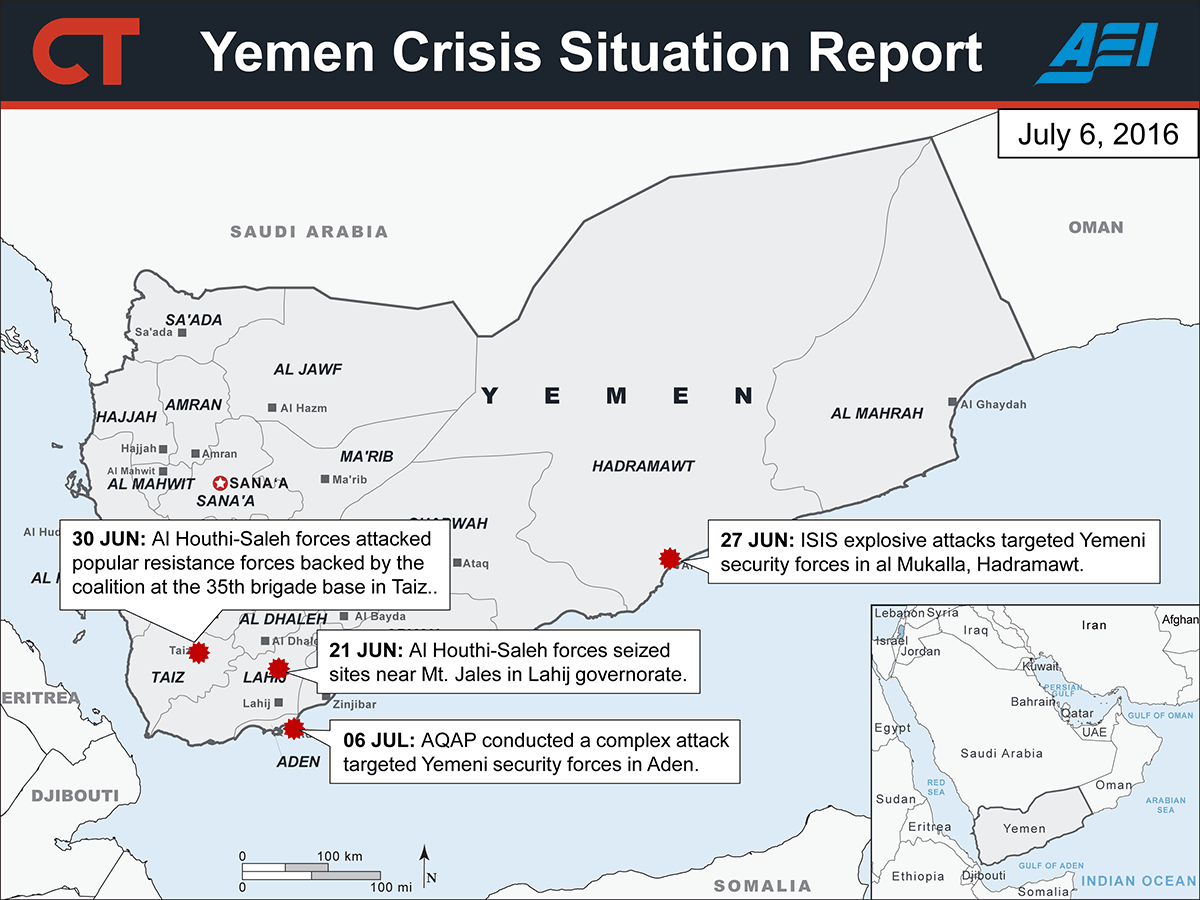The Yemeni government and the Saudi-led coalition may be preparing to attack al Houthi-held Sana’a following the breakdown of the UN-led peace process in Kuwait. The Islamic State of Iraq and al Sham (ISIS) is exploiting the ongoing conflict to derail the reconstitution of the Yemeni state in major port cities. Al Qaeda in the Arabian Peninsula (AQAP) is leveraging this tension to develop relationships with local groups and re-establish strongholds in central and southern Yemen.
Yemeni military forces aligned with President Abdu Rabbu Mansour Hadi may be preparing a military offensive to seize Sana’a to extract concessions from the al Houthi-Saleh alliance. Major General Mohammad Ali al Maqdashi, the general chief of staff for the Yemeni Armed Forces, stated that the military was prepared to defeat the al Houthi-Saleh alliance if the political leadership called for it. Military preparations coincide with the suspension of the UN-led peace process in Kuwait after 77 days of negotiations that achieved no significant progress. The Hadi government issued a statement on July 1 that noted “fundamental differences” with the al Houthi-Saleh delegation. Local southern sources had reported that Hadi’s vice president, Lieutenant General Ali Mohsen al Ahmar, was actively recruiting southerners to join the military forces in Ma’rib to prepare for the Sana’a fight. Saudi Arabia delivered military vehicles to Ma’rib in preparation for a large battle, while the Emiratis have signaled that they do not support further offensive military actions.
Fissures within the al Houthi movement may be becoming visible as the conflict protracts. The leader of the al Haqq party in Yemen, a Zaydi Shi’a party that had historically aligned with al Houthi interests, Hassan al Zeid, led an effort to remove the head of the al Houthi Supreme Revolutionary Committee Saleh al Samad from his position, according to a June 22 Facebook post from an al Houthi media spokesman. The al Houthi position at the Kuwait talks may be the source of tension, as the delegation may lack a unified position with respect to a roadmap proposed by the UN Special Envoy to Yemen. Al Houthi representatives are also engaged in direct talks with Saudi officials, even after the suspension of the Kuwait talks, indicating that some factions may be pursuing a settlement independently. Al Houthi delegation spokesman Mohammed Abdul Salam arrived in Saudi Arabia on July 1 to discuss the issues that have led to roadblocks in Kuwait.
The Islamic State of Iraq and al Sham (ISIS) conducted a coordinated attack in al Mukalla, Hadramawt, as forecast. ISIS Wilayat Hadramawt claimed credit for four simultaneous blasts targeting Yemeni security forces—three checkpoints and a military compound—in the port city on June 27. The attacks killed at least 42 people, striking when the security forces were breaking their Ramadan fast. (Claim obtained through SITE.) Yemeni security forces thwarted an attempted suicide bombing at a mosque in al Mukalla on June 15. ISIS Wilayat Hadramawt and Wilayat Aden are prosecuting a campaign to derail the re-establishment of the central Yemeni government in the respective port cities. ISIS should be able to sustain these efforts in Yemen despite being “riven with factionalism,” as CIA director John Brennan described the group on June 16.
Al Qaeda in the Arabian Peninsula (AQAP) continues to fight alongside Yemeni militias against the al Houthi-Saleh forces, a relationship that strengthens the group, and is re-emerging in southern Yemen. AQAP is also targeting the Yemeni security forces in order to prevent the reconstruction of the Yemeni central state. AQAP claimed a complex attack against a military base in Aden on July 6 as being in retaliation for coalition-backed bombings in Lahij governorate. (Statement obtained through SITE.) AQAP claimed multiple attacks along the al Houthi-Saleh frontlines in Taiz, Ibb, and al Bayda governorates, and a June 15 AQAP video shows AQAP militants clashing with al Houthis in the Zahir mountains in al Bayda. (Statements obtained through SITE.) AQAP’s role in supporting the anti-al Houthi fight has helped build ground support for the group, especially in al Bayda. The group emphasizes that its members fight within certain bounds—a distinction from ISIS—and expelled two members in Taiz for violating guidance. AQAP is also re-emerging in Abyan governorate, according to reports, and it has begun a targeted assassination campaign similar to the one it ran in 2012 against local leaders who oppose the group. U.S. airstrikes continue to target AQAP, though the effect on the group’s capabilities is limited. An American Special Operations team of advisers remains deployed to Yemen to assist the Emirate counter-terrorism operations and a second team is assessing local powerbrokers that may cooperate against AQAP in the future.
Al Houthi-Saleh forces have advanced against the frontline in Lahij and Taiz, reversing many of the Saudi-led coalition’s gains. Al Houthi-Saleh forces seized positions in al Qabaytah and Mt. Jales in Lahij governorate, along the road from Taiz to al Anad airbase, in mid June. Yemeni security forces and popular resistance militias began a large counter-offensive at the end of June against the al Houthi-Saleh positions, and fighting is ongoing. The al Houthi-Saleh forces have also regained ground in and around Taiz city, though reports indicate that Yemeni army forces and popular resistance militias may be mobilizing to counter these gains. Fighting has centered on control of the 35th brigade base in western Taiz city, which the Saudi-led coalition secured in August 2015. Clashes also continue in Nihm district in northeastern Sana’a, near al Hazm, the capital of al Jawf governorate, and in Haradh, in Hajjah governorate.
Yemeni government forces will attempt to advance westward toward the capital, Sana’a, as the Saudi-led coalition intensifies its air campaign on the capital in preparation for a ground offensive. UN-led peace talks are unlikely to resume as scheduled on July 15 due to escalating hostilities, and the protracted conflict will draw focus away from the counter-AQAP and counter-ISIS fights.
Emily Estelle, Nicholas Jonsson and Bailey Palmer contributed significant research to this situation report.

